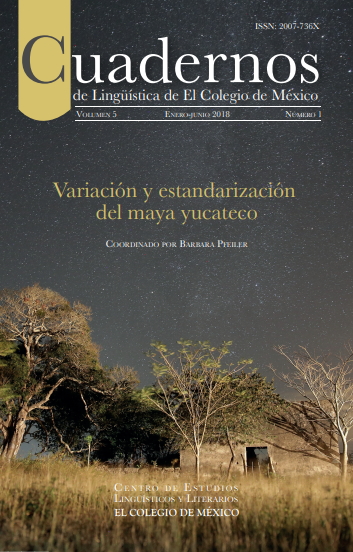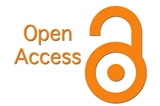<em>Variation and standardization of Yucatec Maya.</em>
DOI:
https://doi.org/10.24201/clecm.v5i1.102Keywords:
Yucatec Maya, linguistic variation, standardization, orthography, morphophonemic writing.Abstract
The concepts of variation, standardization and normalization are defined, adducing examples from different languages. These concepts are applied to Yucatec Maya, the book Normas de escritura para la lengua maya edited by Briceño Chel and Can Tec (2014) serving as a concrete and up-to-date example. In the critical discussion, it is shown what the purpose of standardization and what its theoretical basis is, which aspects of a language it applies to and how it is executed concretely. The discussion concludes with recommendations for the next edition of the Normas.Downloads
References
Andrade, Manuel J. 1955. A grammar of Modern Yucatec (Microfilm Collection of Manuscripts on Middle American Cultural Anthropology, 41). Chicago: University of Chicago Library. http://www.christianlehmann.eu/ling/sprachen/maya/andrade/index.html
Beltrán de Santa Rosa, Pedro. 1859 [1746]. Arte del idioma maya, reducido a sucinctas reglas, y semilexicon yucateco. 2a ed. (= reimpr.) Mérida.
J.D. Espinosa. Blaha Pfeiler, Barbara & Hofling, Andrew. 2006. Apuntes para la variación dialectal en el maya yucateco. Península 1(1). 27–44.
Briceño Chel, Fidencio & Can Tec, Gerónimo Ricardo (eds.). 2014. U nu'ukbesajil u ts'íibta'al maayat'aan. Normas de escritura para la lengua maya. México: Instituto Nacional de Lenguas Indígenas.
Brody, Michal. 2004. The fixed word, the moving tongue: Variation in written Yucatec Maya and the meandering evolution toward unified norms. Austin: University of Texas, Department of Linguistics. (Tesis doctoral.)
Comisión de Difusión del Alfabeto Maya. 1984. Alfabeto maya acordado en la reunión de agosto de 1984. Mérida, Yucatán: Secretaría de Educación Pública.
Coseriu, Eugenio. 1952. Sistema, norma y habla. Revista de la Facultad de Humanidades y Ciencias 9: 113–177.
Reimpr. Coseriu, Eugenio. 1962. Teoría del lenguaje y lingüística general. 11–113. Madrid: Gredos.
Coseriu, Eugenio. 1981. Los conceptos de ‘dialecto’, ‘nivel’ y ‘estilo de lengua’ y el sentido propio de la dialectologia. Lingüística española actual 3. 1–32.
Haugen, Einar. 1987. Blessings of Babel. Bilingualism and language planning: problems and pleasures (Contributions to the Sociology of Language 46). Berlín: Mouton de Gruyter. DOI: 10.1017/S0047404500014597 Lehmann, Christian 2004ss, La lengua maya de Yucatán. http://www.christianlehmann.eu/ling/sprachen/maya/index.phphttp://www.christianlehmann.eu/ling/sprachen/maya/index.php
Pensado, Carmen. 1996. La velarización castellana /ʃ/ > /x/ y sus paralelos romances. En González Alonso, Alegría (ed.), Actas del III Congreso Internacional de Historia de la Lengua Española: Salamanca, 22 al 27 de noviembre de 1993. Madrid: Arco/Libros; 153–170.
Pfeiler, Barbara. 1997. El xe’ek’ y la hach maya. Cambio y futuro del maya ante la modernidad cultural en Yucatán. En Koechert, Andreas & Stolz, Thomas (eds.), Convergencia e individualidad: Las lenguas mayas entre hispanización e indigenismo (Colección Americana 7), 125–140. Hannover: Verlag für Ethnologie
Thomason, Sarah Grey 2001, Language contact: An introduction. Edimburgo: Edinburgh University Press.
Downloads
Published
How to Cite
-
Abstract2541
-
PDF (Español)1276
-
XML (Español)10291
Issue
Section
License
Authors retain copyright of their work and are free to disseminate it, make copies for any use, and/or deposit in any repository or archive of their choice, but they grant Cuadernos de Lingüística de El Colegio de México the right to publish the work for the first time. Authors agree to acknowledge Cuadernos de Lingüística de El Colegio de México as the site of original publication of their article / note / review through proper citation.
Articles appearing in Cuadernos de Lingüística de El Colegio de México are made available to readers under a Attribution-NonCommercial-NoDerivatives 4.0 International.









